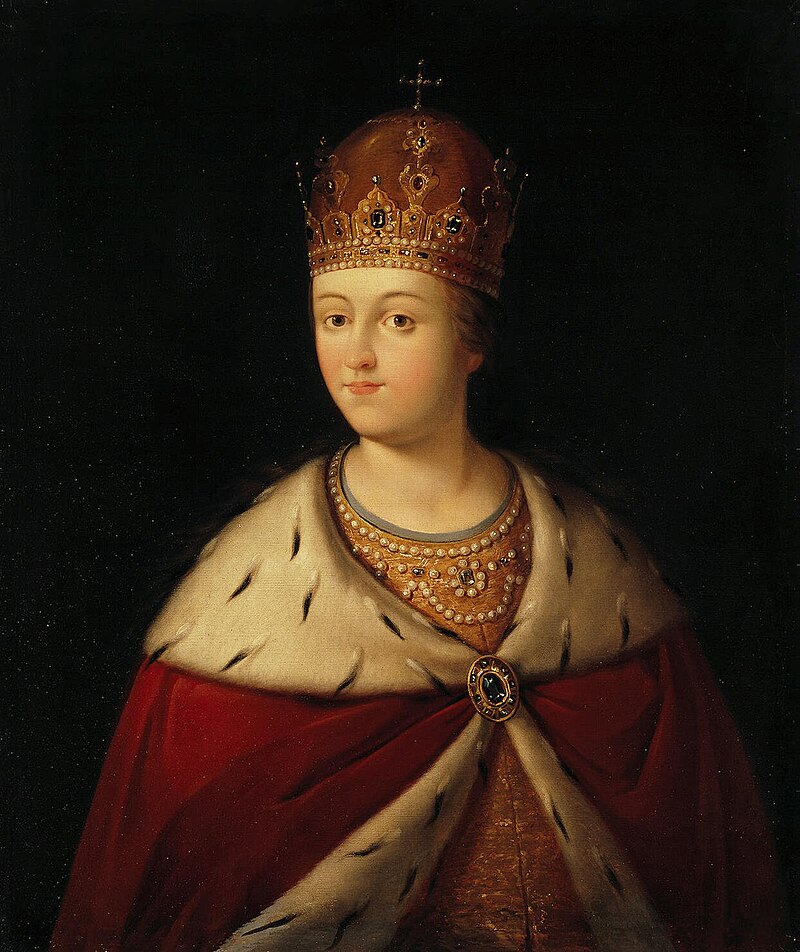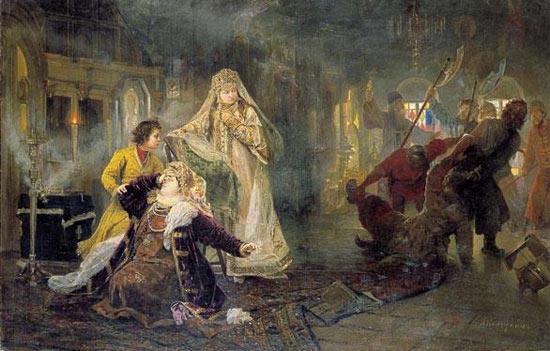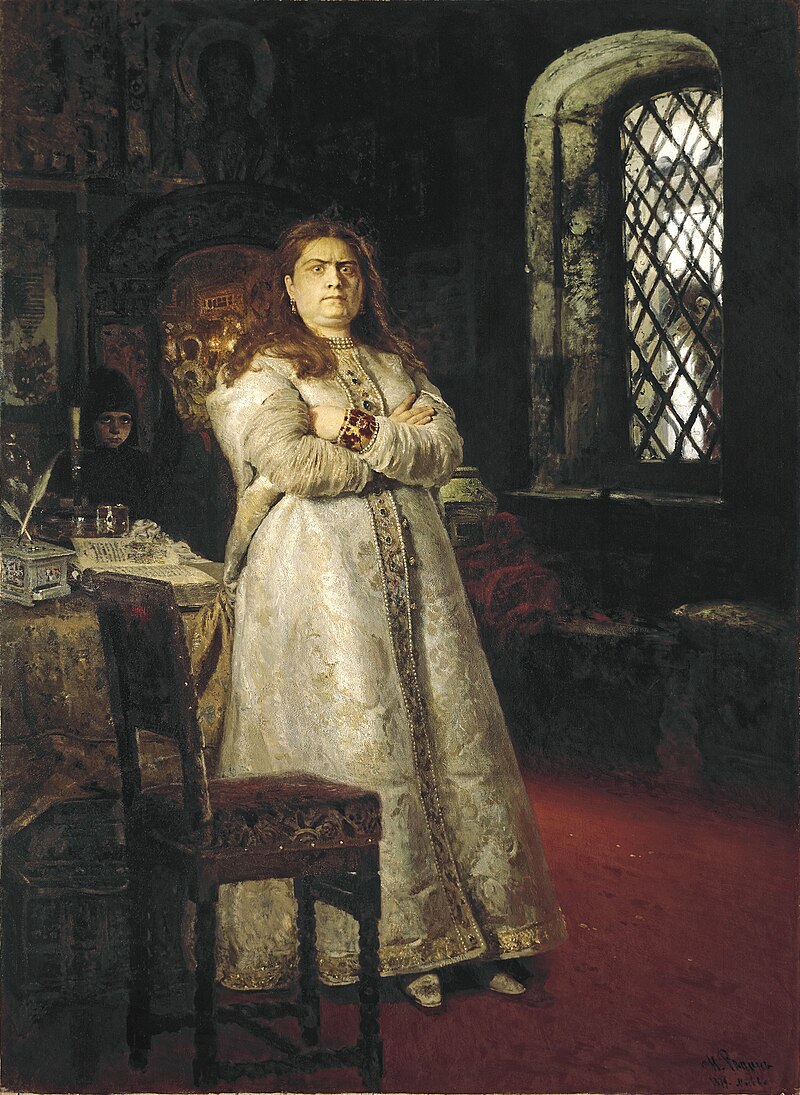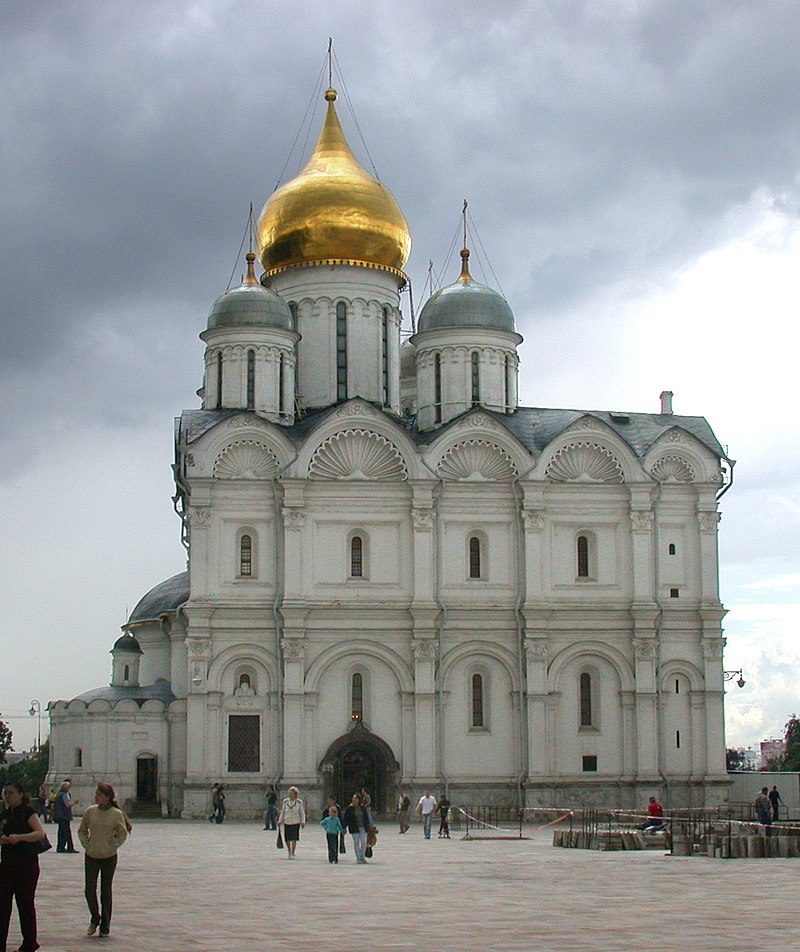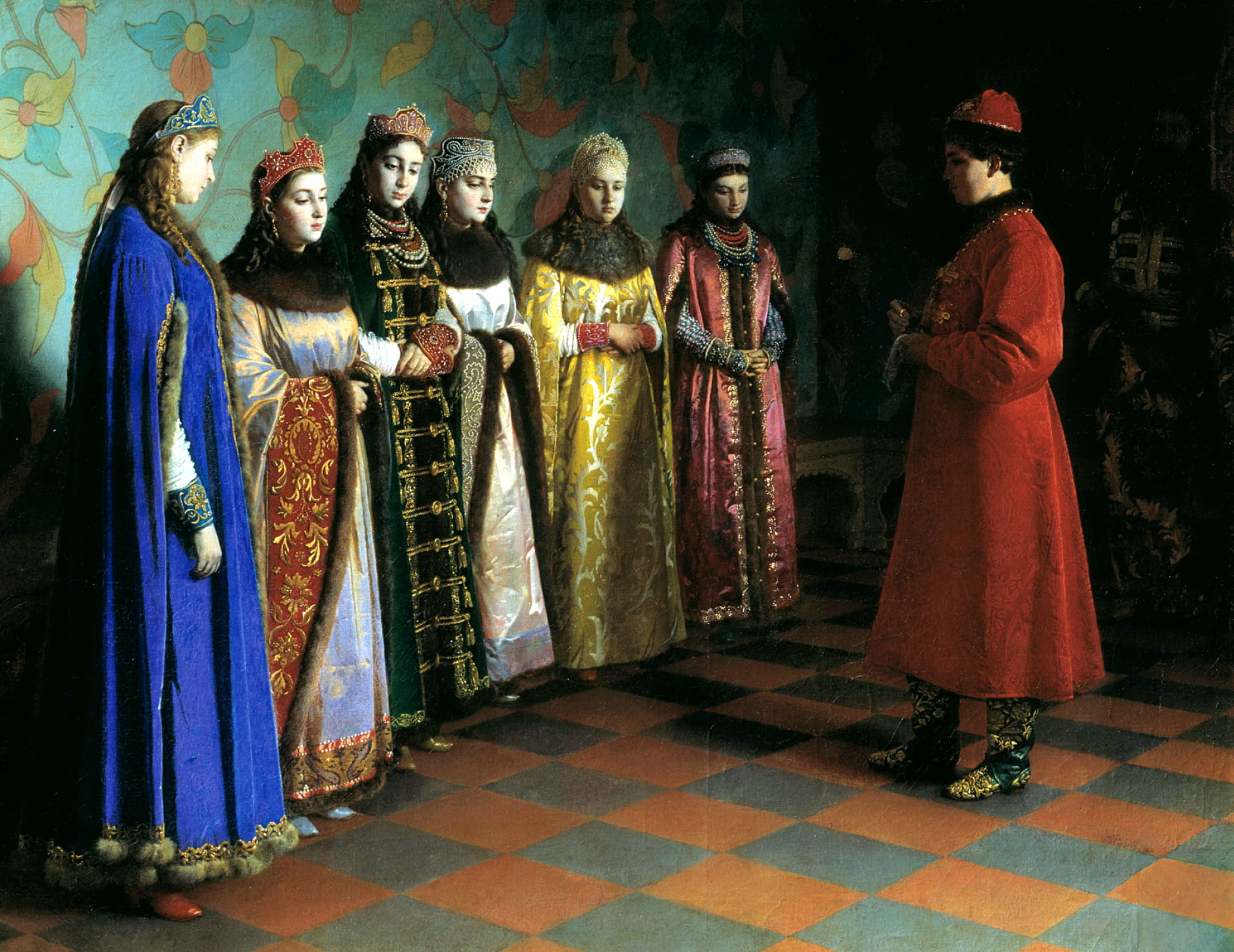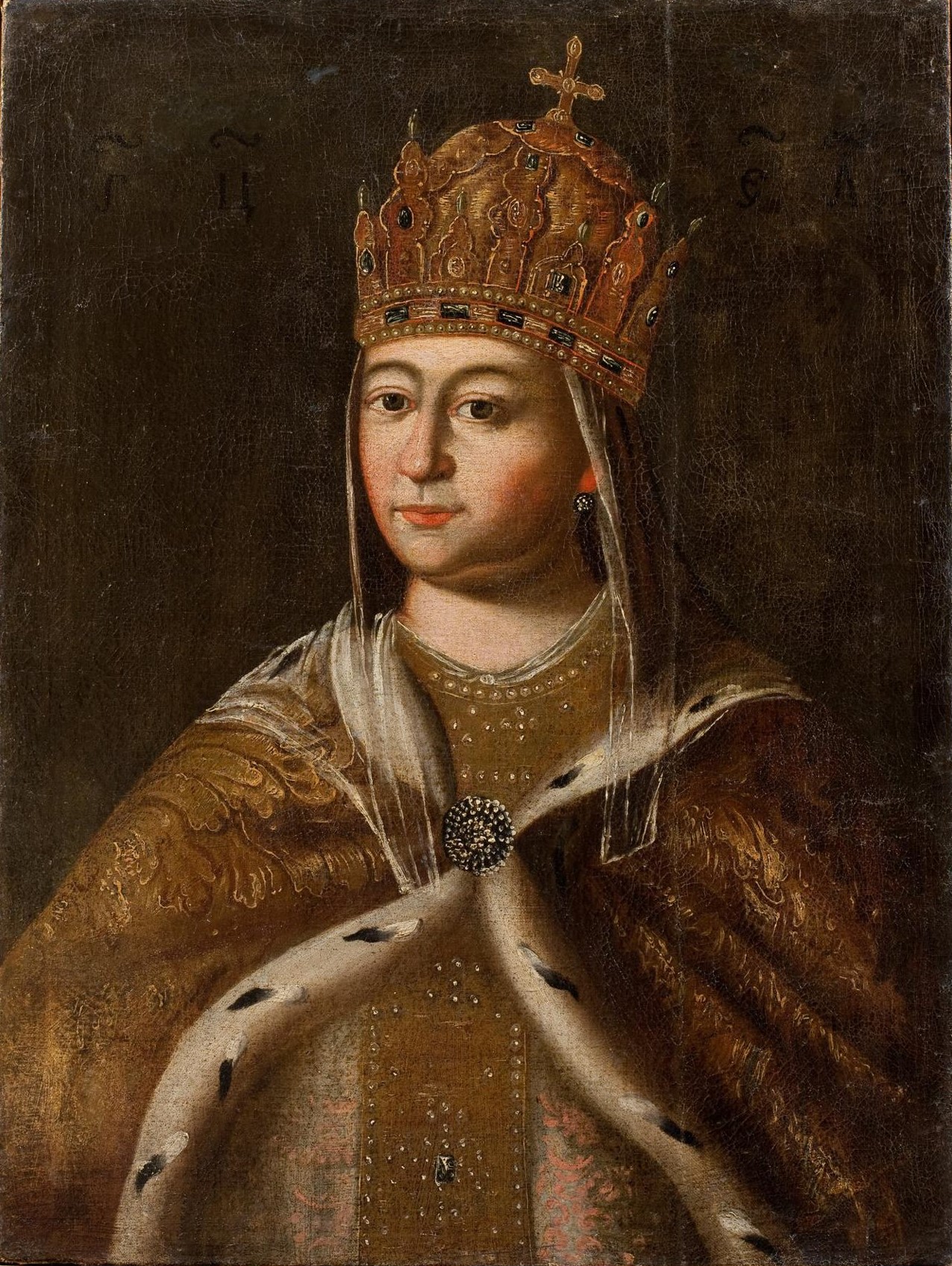by Susan Flantzer © Unofficial Royalty 2018

Praskovia Feodorovna Saltykova, Tsaritsa of All Russia; Credit – Wikipedia
Praskovia Feodorovna Saltykova, the wife of Ivan V, Tsar of All Russia and the mother of Anna I, Empress of All Russia, was born in Moscow, Russia, on October 23, 1664. Her father was Feodor Petrovich Saltykov and her mother was either Yekaterina Fyodorovna <surname unknown> or Anna Mikhailovna Tatishcheva. The Saltykovs were an old Boyar (noble) family as were the Romanovs originally. The later Saltykovs were descended from Tatiana Feodorovna Romanova, a sister of Michael, the first Romanov Tsar.
Praskovia Feodorovna had three siblings:
- Vasily Fedorovich Saltykov (1672 – 1730), married (1) Princess Agrafena Petrovna Prozorovskaya (2) Princess Alexandra Grigorievna Dolgorukova
- Anastasia Fedorovna Saltykova (died 1736), married Prince Ivan Fedorovich Romodanovsky, had one daughter
- Fedosya Fedorovna Saltykova, married Vasily Ivanovich Kasimovsky
When Feodor III, Tsar of All Russia died on May 7, 1682, at the age of 20, he left no children although he had been married twice. His death triggered the Streltsy Uprising of 1682, a struggle for the succession between the families of the two wives of Alexei I, Feodor III’s father. Feodor, the son of Alexei I’s first wife Maria Ilyinichna Miloslavskaya, was followed next in the line of succession by his only surviving full brother, 15-year-old Ivan who was physically and mentally disabled. The family of his father’s second wife Natalya Kirillovna Naryshkina, instead wanted her healthy ten-year-old son Peter (the future Peter I (the Great), Emperor of All Russia) to succeed. The Boyar Duma, a council of Russian nobles, chose Peter to become Tsar of All Russia with his mother as regent.
To protect her brother Ivan’s interests, his sister Sophia Alexeievna led a rebellion of the Streltsy, an elite military corps, in April – May 1682. The rebellion made it possible for Sophia, her maternal family the Miloslavskys, and their allies to insist that Peter and Ivan be proclaimed joint Tsars, with Ivan being the senior Tsar. Sophia acted as Regent during the minority of Ivan V and Peter I. Although Ivan was called the senior Tsar, he never directly dealt with government affairs due to his disability.
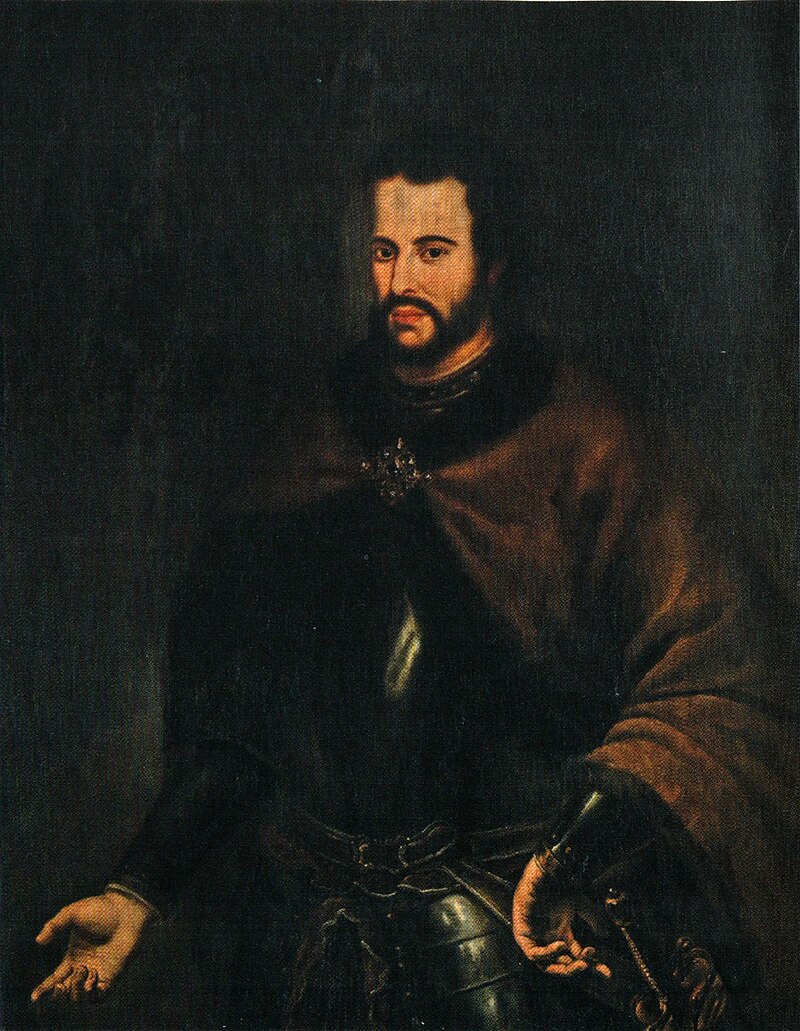
Ivan V, Tsar of All Russia; Credit – Wikipedia
Sophia recognized that her brother Ivan would never be able to truly reign because of his mental and physical disabilities. She thought if she could arrange a marriage for Ivan and if he could father a son, Ivan might be recognized as Russia’s sole Tsar. Sophia could then continue as Ivan’s Regent and if Ivan died before his son reached the age of majority, she could then be her nephew’s Regent. A bride-show, the custom of Byzantine emperors and Russian tsars used to choose a wife from among the most beautiful maidens of the country, was held and 19-year-old Praskovia Feodorovna Saltykova was chosen to be 17-year-old Ivan V’s wife. This was the last time the bride-show was used to choose the wife of the Tsar of Russia. On January 9, 1684, Ivan and Praskovia were married.
For five years, the couple was childless but in 1689, the first of their five daughters was born.
- Tsarevna Maria Ivanovna (1689–1692), died young
- Tsarevna Feodosia Ivanovna (1690–1691), died young
- Tsarevna Ekaterina Ivanovna (1691–1733), married Karl Leopold, Duke of Mecklenburg-Schwerin, had one surviving daughter Elisabeth of Mecklenburg-Schwerin, later known as Grand Duchess Anna Leopoldovna who served as Regent for her infant son Ivan VI, Emperor of All Russia
- Anna Ivanovna, Empress of All Russia (1693–1740), married Friedrich Wilhelm, Duke of Courland who died three months after the wedding, no issue, Anna became Empress of All Russia upon the death of Peter II, Emperor of All Russia, the grandson of Peter I (the Great)
- Tsarevna Praskovia Ivanovna (1694–1731), married Ivan Ilich Dmitriev-Mamonov, had one son who died in childhood
In 1689, 17-year-old Peter I overthrew his half-sister Sophia Alexeievna. Peter I and Ivan V continued as co-rulers, and Sophia was forced to enter a convent and give up her position as a member of the royal family. With Ivan both incapable and disinterested, Peter functioned as though he were the only Tsar, and eventually Ivan became a non-entity in the Russian court. For the last decade of his life, Ivan spent his days with Praskovia fasting and praying and was completely overshadowed by Peter.
By the age of 27, Ivan V was senile, paralyzed, and almost blind. He died on February 8, 1696, at the age of 29. Because Ivan’s children were all daughters, there was no question about the succession upon his death. Peter I (the Great), his half-brother and co-ruler, was left to be Tsar of All Russia and later Emperor of All Russia.

Praskovia Feodorovna in her later years; Credit – Wikipedia
After Ivan’s death, Praskovia lived in Alexei I’s Izmailovo Estate outside of Moscow and began a long-term affair with her steward, the noble Vassili Alexeievich Yushkov who was accepted by Peter I as a member of his sister-in-law’s household. Peter’s surviving daughters Elizabeth (the future Empress) and Anna (the mother of the future Peter III) were educated in Praskovia’s household.
In 1708, Praskovia and her family, by order of Peter I, moved to the new city of St. Petersburg where Peter gifted her with a home on the banks of the Neva River. She had great respect for her brother-in-law Peter I and often served as the first lady, welcoming visitors to the Russian court. Praskovia understood the need for the changes Peter was making in Russia. She raised her daughters and held her court in a modern Western manner, which made her well-regarded by Peter.
Praskovia’s health began to suffer towards the end of her life. On October 24, 1723, the day after her 59th birthday, in St. Petersburg, Russia, Praskovia Fedorovna died. Her funeral, which Peter I attended, was held on November 2, 1723, at the Alexander Nevsky Monastery of St. Petersburg where Praskovia was buried in the crypt of the Annunciation Church in front of the altar.

Annunciation Church at Alexander Nevsky Monastery; Photo Credit – Автор: Gautama buddha – собственная работа, CC BY-SA 3.0, https://commons.wikimedia.org/w/index.php?curid=16548438

Tombstone of Praskovia Feodorovna; Photo Credit – Автор: Shakko – собственная работа, CC BY-SA 3.0, https://commons.wikimedia.org/w/index.php?curid=26602205
This article is the intellectual property of Unofficial Royalty and is NOT TO BE COPIED, EDITED, OR POSTED IN ANY FORM ON ANOTHER WEBSITE under any circumstances. It is permissible to use a link that directs to Unofficial Royalty.
Romanov Resources at Unofficial Royalty
- Tsardom of Russia/Russian Empire Index
- Romanov Births, Marriages and Deaths
- Romanov Burial Sites
- Romanovs Killed During the Russian Revolution
- Romanovs Who Survived the Russian Revolution
Works Cited
- En.wikipedia.org. (2017). Praskovia Saltykova. [online] Available at: https://en.wikipedia.org/wiki/Praskovia_Saltykova [Accessed 19 Dec. 2017].
- Lincoln, W. Bruce. (1981). The Romanovs: Autocrats of All the Russias. New York, NY.: Doubleday
- Ru.wikipedia.org. (2017). Салтыкова, Прасковья Фёдоровна. [online] Available at: https://ru.wikipedia.org/wiki/%D0%A1%D0%B0%D0%BB%D1%82%D1%8B%D0%BA%D0%BE%D0%B2%D0%B0,_%D0%9F%D1%80%D0%B0%D1%81%D0%BA%D0%BE%D0%B2%D1%8C%D1%8F_%D0%A4%D1%91%D0%B4%D0%BE%D1%80%D0%BE%D0%B2%D0%BD%D0%B0 [Accessed 19 Dec. 2017].



